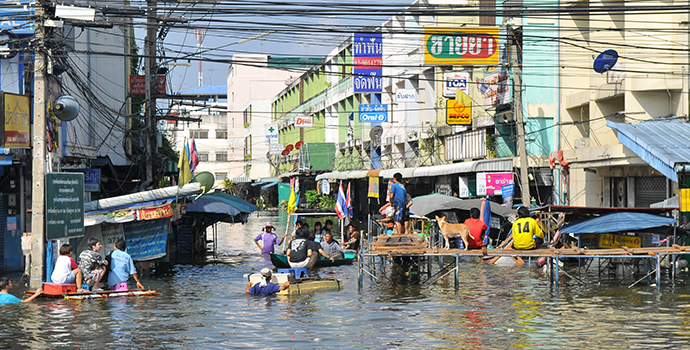- About Us
-
Who we are
-
- Publications
-
- ADPC Academy
-
MediaADPC'S NEWS
Preserving the entrepreneurial spirit: Safeguarding Thailand's small and medium enterprises Preserving the entrepreneurial spirit: Safeguarding Thailand's small and medium enterprises
1 Jul 2015
Bangkok, Thailand
Compared to many countries in Asia, when it comes to risk of natural hazards, Thailand is blessed. The country is situated comfortably west of the ring of fire and is, for the most part, seismically inactive. On Thailand’s Eastern borders, Vietnam and Cambodia act as a buffer from the notoriously calamitous typhoons in the Pacific Ocean. Thailand’s business culture reflects its geological fortune. Based on a study conducted by the Asian Disaster Reduction Center in 2011, zero percent of Thailand’s small and medium enterprises (SMEs) had operational business continuity plans (BCPs). As such, when flooding inundated much of Thailand’s northern and central regions in 2011, SMEs suffered.
SMEs are one of Thailand’s most important competitive assets in an economically accelerating region. According to Thailand’s Office of Small and Medium Enterprises Promotion (OSMEP), SMEs represent more than 99 percent of Thai businesses and approximately 40 percent of the country’s GDP. However, SMEs should not be simplified into abstract assets of the state – they are the creations of individual entrepreneurial business owners, for many of whom the businesses represent hope to transcend socio-economic limitations.
Disasters can crush those hopes. In 2011, more than 550,000 unprepared SMEs saw their business operations severely disrupted causing an approximate loss of 2 billion USD per month for several months during the flooding in Thailand. Business owners all over the country were reminded that disasters could be a cruel barrier to socio-economic mobility.
In 2011, more than 550,000 unprepared SMEs in Thailand saw their business operations severely disrupted by the unprecedented flooding that also affected parts of the capital city of Bangkok.
In response to the tremendous losses suffered by SMEs during the 2011 floods, ADPC implemented the program called Private Sector Engagement in Thailand for Natural Disaster Risk Reduction: Resilient Economies through Business Continuity Planning and Management. Together with its national partners, the Department of Disaster Prevention and Mitigation and OSMEP, ADPC supported SMEs to engage effectively with local government in risk reduction activities; created practical guidelines to train SMEs in developing BCPs; and facilitated the sharing of best practices in the countries of the Asia Pacific Economic Cooperation through an SME Community Forum.
Training courses implemented under the program included two training of trainer courses, several training courses on the implementation of BCPs, and two national workshops to demonstrate good practices within Thailand.
Learning the basics
Despite Thailand’s relative safety from hazards, ADPC was surprised to learn that zero percent of Thai SMEs had operational BCPs. During the training events it became clear that many business owners confused emergency response plans (ERPs) with BCPs. ERPs are required by Thai law and address only what businesses must do during a disaster situation. Examples of ERPs may include an evacuation plan in case of fire or basic safety procedures in case of an earthquake. While ERPs are effective at preventing loss of life, to have only an ERP assumes a myopic understanding of disasters. Businesses directly unharmed by disasters can have their operations indirectly affected.
Seeing firsthand the devastation of the 2011 floods in Thailand made Mr. Sorayut Oungkananukit, Managing Director of the medium-sized IT company Annai, a strong advocate of business continuity planning.
Annai Co. Ltd., a medium-sized IT company in Thailand, was one of the enterprises indirectly affected by the 2011 flooding. “During the floods Annai received no direct damage. However, many of our employees were unable to return to work due to flooding near their homes. It took a long time before the business could return to normal and it affected the confidence of our customers,” says Mr. Sorayut Oungkananukit, Managing Director of the company.
For SMEs the consequences of disasters last from the moment of impact till operations are normalized. A BCP is a framework of actions that a business can take to normalize its operations during a disaster situation whilst minimizing its losses. An effectively devised BCP considers a business’ actions before, during, and after a disaster situation. In its training program, ADPC identifies ten steps for business owners to follow in order to create an effective BCP.
These steps cover a comprehensive range of topics from risk analysis to emergency response to business resumption strategies. The training courses are designed to address a variety of scenarios from a supply chain interruption to the loss of critical infrastructure. In 2014, ADPC succeeded in training a total of 90 SMEs on BCPs.
Finding a plan that fits
When it comes to BCP implementation, ADPC provides business owners with the tools to devise their own plans. Effectiveness depends on the ability of
entrepreneurial business owners to find a plan that is tailored to the idiosyncrasies of their business models.
“Securing data is a main objective for an information technology company like Annai. When devising a BCP for the company, we made it a priority to backup our data onto a cloud. This solution not only prevents the loss of crucial data, but allows employees to access data even if they are unable to commute to the office,” states Mr. Oungkananukit.
While information technology companies like Annai focus on the preservation and accessibility of data, manufacturing and service-oriented companies must focus on the restoration of function.
ADPC’s training courses on business continuity planning are designed to address a variety of scenarios from a supply chain interruption to the loss of critical infrastructure.
After attending ADPC’s orientation workshop on BCP for tourism, Mr. Ittirit Kinglek, Managing Director of Ao Nang Princeville Resort and Spa in Krabi, flew back to his hotel to design a BCP. Mr. Kinglek formed a BCP team and assigned managers in each of the hotel’s divisions to analyze their critical business processes and set individualized recovery time objectives. A recovery time objective refers to the acceptable amount of time to restore business function.
There are several variables that can affect a BCP. A large company with thousands of employees may prefer an inflexible plan that reduces delays caused by micromanagement. A small company might employ a flexible plan that better tackles unforeseen variables. In every case, a BCP will require revision and practice to maximize its potential.
Increasing employee morale
BCPs have obvious benefits for SMEs in the longterm. Trained business owners realize that preparing for disasters now means safeguarding a business from losses in the future. Fortunately, the business owners trained by ADPC have not yet had to test their new BCPs in real disaster situations. Nonetheless, many are already seeing the benefits of their efforts.
Mr. Kinglek unexpectedly gained some customer confidence when a hotel guest from the United Kingdom took notice and congratulated his team while drafting their BCP. Mr. Oungkananukit of Annai mentioned that he observed a significant rise in employee morale since he took an interest in business continuity planning.
"During the floods Annai received no direct damage. However, many of our employees were unable to return to work due to flooding near their homes. It took a long time before the business could return to normal and it affected the confidence of our customers", says Mr. Sorayut Oungkananukit, Managing Director of the IT-company Annai.By: Asian Disaster Preparedness Center
Download the Impact Story (pdf).
Latest NewsRelated Trainings
-